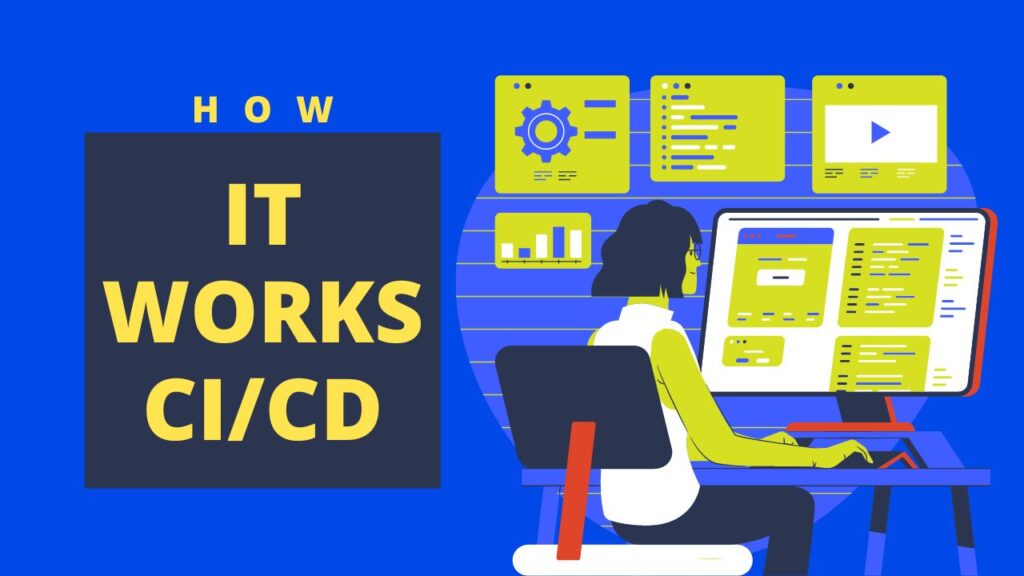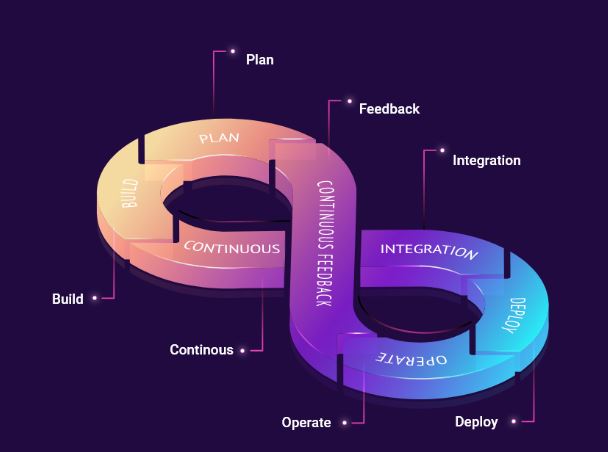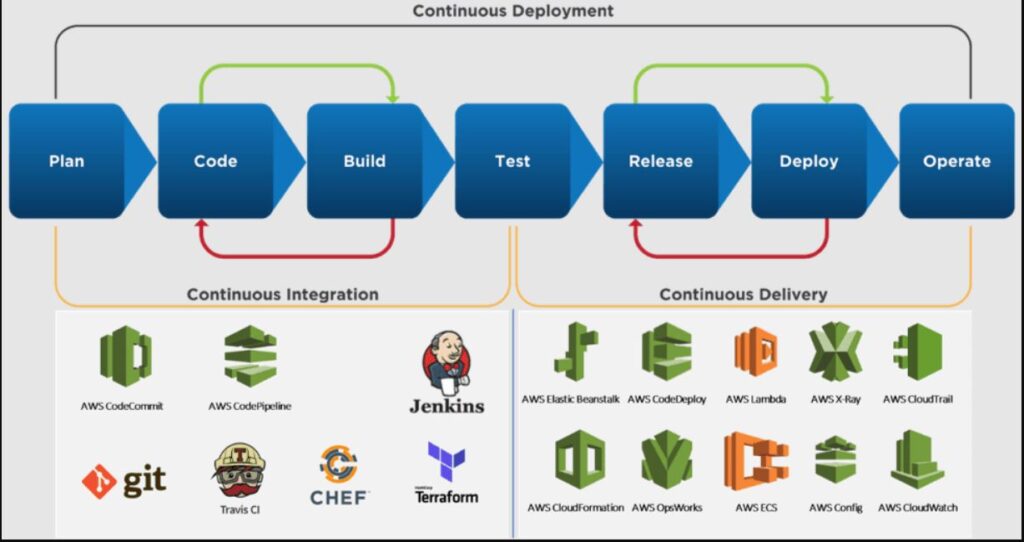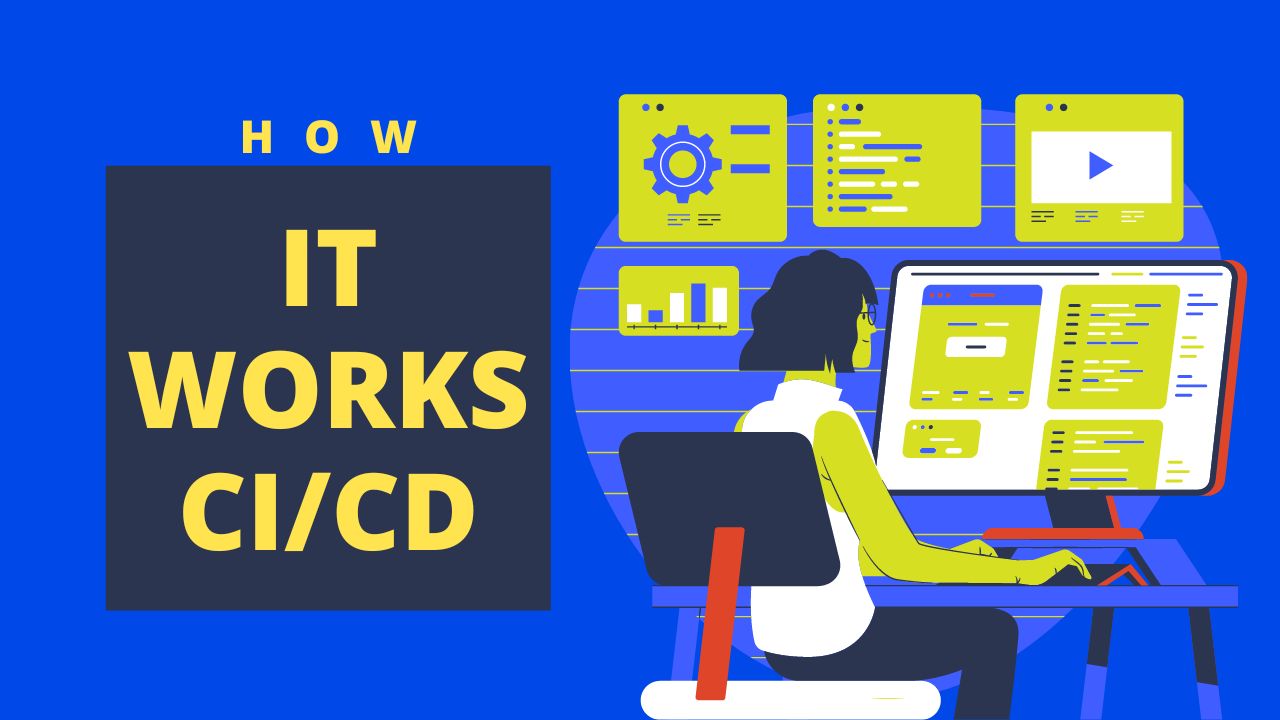Table of Contents
1. Introduction:
Welcome to the world of CI/CD, where software development is not just a process but a journey towards efficiency, reliability, and innovation. In this blog, we’ll delve into the fundamentals of Continuous Integration and Continuous Deployment (CI/CD), exploring how they revolutionize the software delivery process and empower development teams worldwide.
A. Definition of CI/CD:
CI/CD, short for Continuous Integration and Continuous Deployment, is a methodology that combines automated testing and deployment practices to deliver software changes more frequently and reliably. Simply put, CI/CD allows developers to merge their code changes into a shared repository frequently, where automated tests are run to detect and address any issues early in the development cycle.
B. Importance of CI/CD:
In today’s fast-paced software landscape, where agility and quality are paramount, CI/CD plays a pivotal role in driving innovation and accelerating time-to-market. By automating repetitive tasks, such as building, testing, and deployment, CI/CD streamlines the development pipeline, enabling teams to deliver high-quality software at a rapid pace. Moreover, CI/CD fosters collaboration among team members, reduces the risk of integration errors, and enhances overall software reliability.
C. Overview of How CI/CD Streamlines the Software Delivery Process:
Let’s take a closer look at how CI/CD transforms the software delivery process:
- Continuous Integration: With CI, developers integrate their code changes into a shared repository several times a day. With every integration, automated tests are initiated to verify the compatibility of the new code with the existing codebase, ensuring a seamless transition and functionality within the software ecosystem. By detecting and fixing integration issues early, CI promotes code stability and collaboration among team members.
- Continuous Deployment: Once the code passes the automated tests in the CI phase, it’s ready for deployment through CD. Continuous Deployment automates the process of releasing code changes into production environments. By automating deployment tasks, such as provisioning infrastructure and deploying applications, CD reduces the manual effort required and minimizes the risk of human error.

Valuable Points:
- CI/CD fosters a culture of continuous improvement and feedback within development teams.
- By automating tedious tasks, CI/CD frees up developers to focus on innovation and creative problem-solving.
- CI/CD pipelines can be customized to fit the specific needs and workflows of different development projects.
Example:
Consider a software development team working on a web application. With CI/CD in place, developers can push code changes to the shared repository multiple times a day. Automated tests run automatically, ensuring that new features or bug fixes do not introduce regressions. Once the changes pass all tests, they are automatically deployed to the production environment, allowing users to benefit from the latest updates without delay.
In conclusion, CI/CD is not just a set of tools and practices; it’s a game-changer for modern software development. By embracing CI/CD, organizations can deliver high-quality software faster, more efficiently, and with greater confidence.
2. Understanding Continuous Integration (CI)
In the dynamic realm of software development, Continuous Integration (CI) emerges as a pivotal practice, shaping the way teams collaborate, innovate, and deliver. Let’s delve into the essence of CI, exploring its role, benefits, and key components that make it a cornerstone of modern development workflows.

A. Explanation of CI and its role in the development process:
Continuous Integration, often abbreviated as CI, stands as the cornerstone of modern software development methodologies. In essence, CI embodies a collaborative approach wherein developers seamlessly merge their code changes into a central repository on a frequent basis. This practice represents a departure from traditional development methods, where developers might work in isolation for extended periods before integrating their changes, often resulting in complex and error-prone integration processes.
The role of CI in the development process is pivotal. By advocating for frequent integration, CI facilitates a continuous and iterative approach to software development. Instead of waiting until the end of a development cycle to merge disparate code branches, CI encourages developers to integrate their changes early and often. This ensures that integration issues are identified and resolved in a timely manner, preventing the accumulation of technical debt and minimizing the risk of conflicts between different codebases.
Moreover, CI serves as a catalyst for collaboration and transparency within development teams. By integrating their code changes into a shared repository, developers provide visibility into their work, enabling teammates to review, validate, and build upon each other’s contributions. This collaborative ethos fosters a culture of accountability and collective ownership, wherein every member of the team plays a vital role in delivering high-quality software.
In essence, CI is not merely a development practice; it’s a philosophy that embodies the principles of agility, collaboration, and continuous improvement. By embracing CI, development teams can streamline their workflows, accelerate time-to-market, and deliver software that meets the evolving needs of users and stakeholders.
B. Benefits of CI
Among these benefits, two stand out prominently: early bug detection and faster integration of code changes.
Firstly, CI acts as a vigilant gatekeeper, enabling the early detection of bugs within the codebase. By integrating code changes frequently, CI triggers automated tests that meticulously scrutinize the integrity of the software. This proactive approach ensures that any discrepancies or anomalies are identified swiftly, allowing developers to address them before they escalate into more significant issues. Consequently, CI serves as a preemptive measure against the proliferation of bugs, fostering a culture of quality and reliability within the development lifecycle.
Secondly, CI facilitates the swift and seamless integration of code changes into the shared repository. Gone are the days of prolonged integration cycles and cumbersome merges; instead, developers can merge their changes with confidence, knowing that CI will orchestrate the integration process effortlessly. This accelerated integration cycle not only reduces the time and effort required to incorporate new features or fixes but also promotes a more agile and responsive development environment. By eliminating bottlenecks and minimizing downtime, CI empowers teams to iterate rapidly and deliver value to end-users more expeditiously.
In essence, the benefits of CI extend far beyond mere efficiency gains; they encompass a fundamental shift in how software is developed, tested, and delivered. By embracing CI, development teams can cultivate a culture of continuous improvement, where bugs are caught early, changes are integrated seamlessly, and innovation thrives. It’s not just about writing code—it’s about building software that’s reliable, resilient, and ready to meet the demands of an ever-evolving digital landscape.
CI offers a myriad of benefits that propel development teams towards efficiency and excellence:
- Early bug detection: By integrating code changes frequently, CI facilitates the early detection of bugs, allowing developers to address issues when they are easier and less costly to fix.
- Faster feedback loop: CI’s automated testing framework provides rapid feedback on the quality of code changes, enabling developers to iterate and refine their work more swiftly.
- Improved code quality: With CI, developers are encouraged to write modular, well-tested code, resulting in a more stable and maintainable codebase.
- Enhanced team collaboration: CI encourages a collaborative development environment, where developers work in tandem, integrate their changes seamlessly, and collectively own the success of the project.
C. Key components of a CI system
such as automated testing and version control integration: A robust CI system comprises several essential components that streamline the development process:
- Automated testing: Automated tests, including unit tests, integration tests, and acceptance tests, are pivotal in CI, ensuring that code changes do not break existing functionality.
- Version control integration: Integration with version control systems like Git enables developers to manage and track changes efficiently, facilitating seamless collaboration and code review processes.
- Continuous build and integration: CI systems automate the process of building and integrating code changes, allowing teams to detect integration issues early and maintain a stable codebase.
- Deployment automation: While not strictly a part of CI, some CI systems extend into Continuous Deployment (CD), automating the deployment of validated code changes to production environments, further streamlining the delivery pipeline.
Valuable Key Point:
Embracing CI fosters a culture of agility, collaboration, and continuous improvement within development teams, paving the way for faster delivery cycles, higher-quality software, and ultimately, greater customer satisfaction.
Example: Consider a team of developers working on an e-commerce platform. With CI in place, each developer’s code changes are integrated into the shared repository multiple times a day. Automated tests, including unit tests to validate individual components and integration tests to ensure smooth interactions between modules, are triggered automatically. If any issues arise, developers receive immediate feedback, allowing them to address the issues promptly. As a result, the team can deliver new features and bug fixes more rapidly, maintaining a stable and reliable platform for their users.
In conclusion, Continuous Integration is not just a development practice; it’s a catalyst for innovation, collaboration, and excellence in software development. By embracing CI, teams can unlock the full potential of their development process, delivering high-quality software with speed and confidence.
3. Exploring Continuous Deployment (CD) for Agile Software Delivery
That’s where Continuous Deployment (CD) comes into play, revolutionizing the deployment phase and redefining how we deliver software. Let’s embark on a journey to explore the wonders of CD and how it can supercharge your development process!
A. Defining Continuous Deployment (CD):
Continuous Deployment is the practice of automatically deploying code changes to production environments after passing through the entire development pipeline. Unlike Continuous Integration, which focuses on merging code changes frequently, CD takes it a step further by automating the deployment process, ensuring that new features and updates reach users quickly and efficiently.
B. The Power of CD:
Picture this: You’ve just implemented a groundbreaking feature in your application. With CD in place, you can seamlessly push those changes into production with confidence. The advantages of CD are manifold:
- Faster Time-to-Market: By automating deployment, CD reduces the time it takes for new features to go from development to production, enabling you to respond swiftly to market demands and stay ahead of competitors.
- Increased Deployment Frequency: With CD, deployments become a routine part of the development process rather than a cumbersome task. This allows teams to release updates more frequently, delivering value to users in smaller, incremental steps.
C. Key Components of a CD Pipeline:
To understand how CD works, let’s break down its core components:
- Automated Deployment: At the heart of CD is automation. This involves setting up a pipeline that automatically triggers the deployment process whenever new code is merged into the main branch. Tools like Jenkins, GitLab CI, and CircleCI are commonly used to orchestrate this automation.
- Monitoring: Continuous monitoring is essential for ensuring the stability and performance of deployed applications. CD pipelines often include monitoring tools that track key metrics such as response times, error rates, and resource utilization, allowing teams to quickly identify and address any issues that arise post-deployment.
Valuable Point:
Imagine you’re running an e-commerce platform, and you’ve just implemented a new checkout feature. With CD, you can deploy this feature to production in a matter of minutes, allowing customers to experience the seamless checkout process without delay. Moreover, if any issues arise after deployment, your monitoring tools will immediately alert you, enabling you to swiftly address them and maintain a smooth user experience.
In conclusion, Continuous Deployment is a game-changer for modern software development, enabling teams to deliver value to users faster, more frequently, and with greater confidence. By embracing CD, you can unlock new levels of agility, innovation, and success in your development journey. So why wait? Dive into the world of CD today and revolutionize the way you deploy software!
4. The CI/CD Pipeline
Welcome aboard! Today, we’re diving into the exciting world of CI/CD pipelines. Buckle up and get ready for a smooth ride as we explore how these pipelines streamline the journey from code to deployment, making software delivery a breeze.
A. Understanding the CI/CD Pipeline
Alright, let’s start by breaking down what exactly the CI/CD pipeline is all about. Think of it as a well-oiled machine, guiding your code from inception to deployment with precision. The pipeline consists of several key stages, each playing a vital role in the software delivery process.
- Build: This is where the magic begins. Your code is compiled, packaged, and transformed into a deployable artifact. It’s like laying the foundation for a skyscraper – a crucial step to ensure stability and reliability down the line.
- Test: Once the build is complete, it’s time to put your code through its paces. Automated tests are conducted to check for bugs, vulnerabilities, and overall functionality. It’s like having a team of diligent testers working round-the-clock to ensure your software meets quality standards.
- Deploy: With the green light from testing, your code is ready to spread its wings and take flight. It’s deployed to production environments, making it accessible to users worldwide. Imagine launching a rocket into space – precision and efficiency are key to a successful deployment.
B. Visualizing the CI/CD Workflow
Now, let’s paint a picture of what a typical CI/CD workflow looks like. Picture this: you’ve just committed your latest code changes to the repository. Like clockwork, the CI/CD pipeline springs into action.
- Code Commit: You push your changes to the repository, triggering the CI/CD process.
- The CI/CD pipeline kicks into action, triggering a series of automated processes.
- Your code is built, tested, and deployed seamlessly, without any manual intervention.
- Voila! Your changes are live in production, and you can sit back and relax, knowing that everything went smoothly.
- Build & Test: The build stage kicks off, compiling your code and running automated tests. Any issues are flagged and addressed before proceeding to the next stage.
- Deployment: Once your code passes all tests, it’s deployed to production servers. This can be done seamlessly and quickly, thanks to automation.
C. The Role of Automation in Efficiency and Reliability
Automation is the secret sauce that keeps the CI/CD pipeline running smoothly. By automating repetitive tasks, developers can focus on what they do best – writing code. Here’s why automation is key at every stage of the pipeline:
- Efficiency: Automation streamlines the development process, reducing manual errors and accelerating time-to-market. For example, automated testing frameworks can run thousands of tests in minutes, significantly speeding up the feedback loop.
- Reliability: Consistency is key in software development. Automation ensures that every code change undergoes the same rigorous testing process, regardless of time or day. This leads to more reliable software and happier end users.
- Scalability: As your project grows, automation allows you to scale your CI/CD pipeline effortlessly. Whether you’re deploying to a handful of servers or a global fleet of containers, automation has got you covered.
Remember, automation doesn’t mean sacrificing control. You still have full visibility and oversight of the entire process, with the added bonus of increased speed and efficiency.
Example: Imagine you’re running an e-commerce website, and you need to deploy a new feature in time for the holiday season. With CI/CD automation, you can push out updates quickly and confidently, knowing that your pipeline will handle the heavy lifting, even during peak traffic periods.
In a nutshell, the CI/CD pipeline is like your trusty co-pilot, guiding you through the twists and turns of software development. Embrace automation, visualize your workflow, and watch your code soar to new heights!
5. Tools and Technologies for CI/CD
When it comes to Continuous Integration and Continuous Deployment (CI/CD), the market is flooded with a plethora of options. Let’s embark on a journey to explore the landscape of CI/CD tools and find the perfect fit for your development environment.

A. Overview of Popular CI/CD Tools:
When it comes to CI/CD, several tools have gained widespread popularity for their effectiveness and versatility.
- Jenkins: Known for its robustness and extensibility, Jenkins is an open-source automation server that facilitates continuous integration and delivery. With a vast plugin ecosystem and strong community support, Jenkins remains a top choice for many development teams.
- GitLab CI: Integrated seamlessly within the GitLab platform, GitLab CI offers a comprehensive CI/CD solution. From version control to continuous integration and deployment, GitLab CI provides a unified environment for managing the entire software development lifecycle.
- CircleCI: Renowned for its simplicity and speed, CircleCI enables teams to automate their build, test, and deployment processes with ease. With support for various programming languages and cloud platforms, CircleCI empowers developers to ship code faster and more efficiently.
B. Comparison of Different CI/CD Solutions:
While each CI/CD tool offers unique features and capabilities, it’s essential to evaluate them based on your specific requirements. Here are some factors to consider when comparing CI/CD solutions:
- Scalability: Assess the scalability of the CI/CD tool to accommodate your project’s growth and increased workload over time.
- Integration: Evaluate the tool’s compatibility with your existing development stack, including version control systems, issue trackers, and cloud platforms.
- Customization: Look for flexibility in configuring workflows, pipelines, and automation rules to align with your team’s unique processes and preferences.
- Support and Documentation: Consider the availability of support resources, documentation, and community forums to assist you in troubleshooting and learning.
C. Considerations for Selecting the Right CI/CD Tool:
Choosing the right CI/CD tool requires careful consideration of various factors.
- Identify Your Needs: Define your project requirements, team size, budget constraints, and specific features you need in a CI/CD tool.
- Conduct Trials and POCs: Take advantage of free trials, demos, and proof-of-concepts to test different CI/CD tools in a real-world environment.
- Gather Feedback: Solicit feedback from your development team, stakeholders, and industry peers who have experience with the CI/CD tools you’re considering.
- Plan for Growth: Choose a CI/CD tool that can scale with your organization’s growth and evolving needs, allowing you to stay agile and competitive in the long run.
Example: Suppose your development team predominantly uses Docker containers for application deployment. In that case, you may prioritize CI/CD tools that offer seamless integration with Docker and container orchestration platforms like Kubernetes.
In conclusion, selecting the right CI/CD tool is crucial for streamlining your development workflow, improving productivity, and delivering high-quality software. By understanding your needs, comparing different solutions, and considering key factors, you can find the perfect CI/CD tool that aligns with your goals and objectives. Happy coding!
6. Best Practices for Implementing CI/CD
Introduction:
Congratulations on taking the leap into Continuous Integration and Continuous Deployment (CI/CD)! Embracing CI/CD practices can revolutionize your development process, leading to faster delivery, improved quality, and happier teams. In this section, we’ll explore some best practices to ensure that your CI/CD journey is smooth and successful.
A. Guidelines for setting up an effective CI/CD process within your organization:
Setting up an effective CI/CD process requires careful planning and consideration.
- Define clear objectives: Clearly outline your goals and objectives for implementing CI/CD. Whether it’s reducing time-to-market, improving code quality, or enhancing collaboration, having a clear vision will guide your CI/CD strategy.
- Start small and iterate: Begin with a small, manageable project to pilot your CI/CD implementation. This allows you to experiment, learn from mistakes, and iterate on your process before scaling up to larger projects.
- Foster a culture of collaboration: CI/CD is not just about tools and automation; it’s also about fostering a collaborative culture within your team. Encourage communication, feedback, and knowledge sharing to ensure that everyone is aligned and invested in the CI/CD process.
- Investing in training and education for your team members is not just a checkbox to tick off; it’s an essential aspect of nurturing a culture of continuous improvement and innovation within your organization. Here’s why providing comprehensive training and education on CI/CD tools and practices is crucial:
- Empowerment through Knowledge: By equipping your team with the necessary skills and knowledge, you empower them to take ownership of the CI/CD process. Training provides them with the confidence to navigate CI/CD tools effectively, troubleshoot issues, and contribute meaningfully to the development pipeline.
- Efficiency and Productivity: Well-trained team members are more efficient and productive in their roles. They can leverage CI/CD tools to automate repetitive tasks, streamline workflows, and deliver code changes more quickly and reliably. This efficiency translates into faster time-to-market for new features and enhancements.
- Adaptability to Change: The technology landscape is constantly evolving, and CI/CD practices are no exception. Investing in training ensures that your team stays abreast of the latest tools, techniques, and best practices in CI/CD. This adaptability enables your organization to embrace new technologies and methodologies as they emerge, staying competitive in a rapidly changing market.
- Collaboration and Team Cohesion: Training sessions provide opportunities for team members to collaborate, share knowledge, and learn from each other’s experiences. This collaboration fosters a sense of team cohesion and camaraderie, strengthening bonds and enhancing communication within the team.
- Quality and Reliability: A well-trained team is better equipped to uphold quality standards and ensure the reliability of your software delivery pipeline. They understand the importance of rigorous testing, code reviews, and continuous monitoring in maintaining the integrity of the CI/CD process, ultimately delivering higher-quality software to end-users.
- To make your training and education initiatives truly effective, consider incorporating a mix of formats, such as workshops, seminars, hands-on exercises, and online courses. Tailor the content to address the specific needs and skill levels of your team members, providing both foundational knowledge and advanced topics as required. Encourage active participation and feedback to create an engaging and interactive learning environment.
- Remember, investing in training and education is an investment in your team’s growth, development, and ultimately, the success of your CI/CD initiatives. By prioritizing continuous learning and skill development, you lay the foundation for a culture of excellence and innovation that propels your organization forward in its CI/CD journey.
Example: At XYZ Software, we implemented CI/CD by starting with a small cross-functional team working on a new feature. By clearly defining our objectives, fostering collaboration between developers and operations, and providing training on CI/CD tools, we were able to successfully roll out our CI/CD process across the organization.
B. Tips for optimizing CI/CD pipelines for speed, reliability, and scalability:
Optimizing your CI/CD pipelines is essential for maximizing efficiency and effectiveness. Here are some tips to help you optimize your pipelines:
- Keep your pipelines simple and modular: Break down your pipelines into smaller, modular components to improve maintainability and scalability. Avoid monolithic pipelines that are difficult to manage and debug.
- Parallelize tasks: Parallelize tasks wherever possible to reduce build times and improve overall pipeline performance. This can include running tests in parallel, parallelizing deployment stages, and optimizing resource utilization.
- Use caching and artifact management: Implement caching and artifact management strategies to speed up build times and reduce dependencies. Cache commonly used dependencies and artifacts to avoid redundant builds and downloads.
- Monitor and optimize performance: Continuously monitor your CI/CD pipelines for performance bottlenecks and areas for optimization. Use metrics and analytics to identify areas of improvement and iterate on your pipelines accordingly.
Example: By parallelizing our test suites and implementing caching for dependencies, we were able to significantly reduce our build times from hours to minutes, allowing us to deliver new features to customers faster than ever before.
C. Common pitfalls to avoid when adopting CI/CD practices:
While CI/CD offers many benefits, there are also common pitfalls to be aware of. Here are some pitfalls to avoid:
- Neglecting testing and quality assurance: Don’t sacrifice quality for speed. Ensure that you have robust testing and quality assurance processes in place to catch bugs and prevent regressions.
- Overcomplicating your pipelines: Avoid over-engineering your pipelines with unnecessary complexity. Keep your pipelines simple, focused, and easy to understand.
- Ignoring security and compliance: Don’t overlook security and compliance requirements when implementing CI/CD. Ensure that your pipelines adhere to security best practices and compliance standards.
- Lack of automation and integration: CI/CD is all about automation and integration. Don’t rely on manual processes or siloed tools. Invest in automation and integration to streamline your workflows and improve efficiency.
Example: At ABC Corporation, we initially struggled with overcomplicating our CI/CD pipelines, leading to frequent failures and delays. By simplifying our pipelines and focusing on automation and integration, we were able to overcome these challenges and achieve smoother, more reliable deployments.
Conclusion: Implementing CI/CD is a journey, not a destination. By following these best practices and learning from both successes and failures, you can build a robust CI/CD process that accelerates your software delivery and drives innovation within your organization. Remember to stay agile, iterate often, and continuously improve your CI/CD practices to stay ahead of the curve.
7. Real-world Examples of CI/CD Implementation
In the fast-paced world of software development, CI/CD has emerged as a game-changer, revolutionizing the way teams build, test, and deploy code. Let’s delve into real-world examples of CI/CD implementation, where organizations have harnessed its power to drive innovation and achieve remarkable results.
A. Case Studies of CI/CD Triumphs
- Tech Giant’s Swift Deployment: Imagine a tech giant aiming to update its flagship app swiftly while maintaining stability. By implementing CI/CD pipelines, they automated the entire process, from code integration to deployment. As a result, they slashed release cycles from weeks to mere hours, ensuring rapid feature rollouts without compromising quality.
- E-commerce’s Continuous Delivery: Picture an e-commerce platform striving to stay ahead in the competitive market. Through CI/CD adoption, they achieved continuous delivery, enabling them to push new features and updates seamlessly. By automating testing and deployment, they reduced the risk of errors and downtime, resulting in improved customer satisfaction and increased revenue.
B. Lessons Learned from CI/CD Pioneers
- Culture of Collaboration: Organizations that excel in CI/CD embrace a culture of collaboration and transparency. Teams work together seamlessly, breaking down silos between development, testing, and operations. By fostering a collaborative environment, they ensure smooth integration and delivery of code changes.
- Iterative Improvement: CI/CD is not a one-time implementation; it’s a journey of continuous improvement. Successful organizations understand the importance of feedback loops and iteration. They monitor performance metrics, gather user feedback, and iterate on their CI/CD processes to adapt to evolving needs and technologies.
C. Insights into CI/CD’s Impact
- Boosted Productivity: With CI/CD, organizations witness a significant boost in productivity. By automating repetitive tasks and streamlining workflows, developers can focus more on coding and innovation, leading to faster time-to-market and increased productivity.
- Enhanced Quality and Reliability: CI/CD fosters a culture of quality and reliability. Automated testing ensures that bugs are caught early in the development cycle, reducing the likelihood of critical issues in production. This leads to higher-quality software and improved customer satisfaction.
- Business Agility: CI/CD empowers organizations to respond quickly to market changes and customer feedback. With the ability to deploy code changes rapidly and reliably, businesses can stay agile and competitive in today’s dynamic landscape.
In conclusion, the real-world examples of CI/CD implementation showcase its transformative impact on development workflows and business outcomes. By learning from these success stories and embracing CI/CD methodologies, organizations can unlock their full potential and drive innovation at scale.
8. Future Trends in CI/CD
In the ever-evolving world of software development, CI/CD stands at the forefront as a cornerstone of efficiency and agility. As we peer into the crystal ball of technology, it’s fascinating to envision the future trends that will shape the CI/CD landscape. Let’s embark on a journey to explore what lies ahead and how we can prepare to ride the wave of innovation.
A. Exploration of Emerging Trends and Innovations in CI/CD Practices
The future of CI/CD is brimming with exciting possibilities, fueled by emerging trends and innovations. One such trend is the rise of “GitOps,” a methodology that leverages Git repositories as the single source of truth for infrastructure and deployment automation. With GitOps, teams can achieve greater consistency, transparency, and traceability in their CI/CD processes.
Moreover, we’re witnessing a growing adoption of “AI-driven CI/CD,” where machine learning algorithms analyze vast amounts of data from development pipelines to optimize workflows, predict failures, and automate decision-making. This intelligent automation not only enhances efficiency but also empowers teams to focus on higher-value tasks.
B. Predictions for How CI/CD Will Continue to Evolve in the Coming Years
Looking ahead, it’s clear that CI/CD will continue to evolve to meet the demands of modern software development practices. One prediction is the convergence of CI/CD with other DevOps practices, such as continuous testing and continuous monitoring, to form a unified and seamless delivery pipeline. This convergence will blur the lines between development, testing, and operations, enabling faster feedback loops and smoother deployments.
Additionally, the proliferation of cloud-native technologies and containerization will drive the adoption of “CI/CD as Code,” where infrastructure and deployment pipelines are treated as version-controlled code. This paradigm shift will enable teams to manage their entire CI/CD process programmatically, leading to greater scalability, reproducibility, and portability across different environments.
C. Considerations for Staying Ahead of the Curve and Adapting to Changes in the CI/CD Landscape
As CI/CD continues to evolve, it’s essential for organizations to stay ahead of the curve and adapt to changes in the landscape. One key consideration is investing in continuous learning and upskilling to keep pace with emerging technologies and best practices. By fostering a culture of learning and experimentation, teams can embrace change with confidence and harness the full potential of CI/CD.
Furthermore, collaboration and knowledge-sharing within the developer community play a crucial role in driving innovation and staying informed about the latest trends in CI/CD. Participating in conferences, meetups, and online forums can provide valuable insights and networking opportunities to exchange ideas and experiences with peers.
9. Conclusion
In conclusion, the future of Continuous Integration and Continuous Deployment, holds immense promise, marked by innovation, collaboration, and continuous improvement. By embracing emerging trends, making informed predictions, and staying adaptable, we can navigate the ever-changing landscape of software delivery with confidence and excitement. So, let’s embark on this journey together and pave the way for a brighter future powered by Continuous Integration and Continuous Deployment.
A. Let’s summarize the main takeaways from our exploration of CI/CD throughout this blog
Throughout this blog, we’ve delved into the world of Continuous Integration and Continuous Deployment, unraveling its significance and impact on modern software development. We began by understanding the essence of Continuous Integration (CI) and Continuous Deployment (CD), recognizing how they work hand in hand to streamline the software delivery process. Exploring the Continuous Integration and Continuous Deployment, pipeline, we witnessed the seamless flow of code from development to production, facilitated by automation and rigorous testing.
B. Final thoughts on the importance of Continuous Integration and Continuous Deployment, in modern software development
In today’s fast-paced digital landscape, the importance of Continuous Integration and Continuous Deployment, cannot be overstated. It’s not just about delivering software faster; it’s about delivering software reliably and with confidence. Continuous Integration and Continuous Deployment, empowers teams to iterate quickly, respond to feedback, and deliver value to users more efficiently. By embracing Continuous Integration and Continuous Deployment, practices, organizations can foster a culture of collaboration, innovation, and continuous improvement, ultimately driving business success in a competitive market.
C. Encouragement for readers to explore and implement Continuous Integration and Continuous Deployment, practices in their own projects
To our readers, we extend a heartfelt invitation to embark on your own Continuous Integration and Continuous Deployment, journey. Whether you’re a seasoned developer or just starting out, there’s immense value in embracing Continuous Integration and Continuous Deployment, practices in your projects. Start small, experiment, and iterate. Leverage the wealth of Continuous Integration and Continuous Deployment, tools and resources available to you, and don’t be afraid to seek guidance from the vibrant community of practitioners. By implementing Continuous Integration and Continuous Deployment, practices, you’ll not only accelerate your development cycles but also enhance the quality, reliability, and scalability of your software. So, dare to innovate, dare to automate, and let Continuous Integration and Continuous Deployment, be your guiding light on the path to software excellence.
In closing, we thank you for joining us on this Continuous Integration and Continuous Deployment, journey. May your code be clean, your builds be green, and your deployments be seamless. Here’s to a future fueled by continuous integration, continuous deployment, and continuous improvement. Happy coding!



